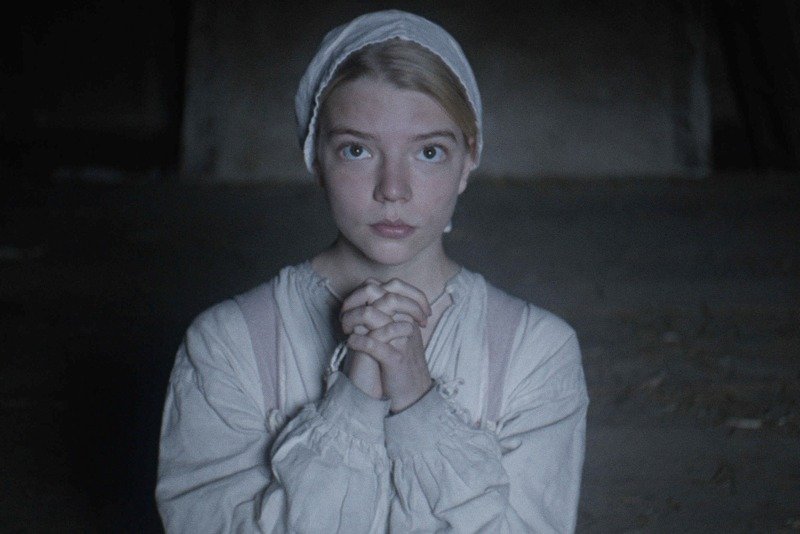Warning: “The Witch: A new england folktale”
Virginia Gray ‘20
“A finely calibrated shiver of a movie...”
-Manohla Dargis, The New York Times
I’d been dying to see Robert Eggers’ first major film, The Witch (or The VVitch) since its debut in 2016; it looked like the kind of dark, slow-burn thriller I always love. So, protected by my cat and quilt one gloomy Saturday night, my friend Laura and I hunkered down to watch it.
The Witch follows a devout Puritan family in colonial New England, recently exiled from their village for social views that conflicted with those of the village leaders’. Paranoia and despair sets in when the couples’ infant, Samuel, goes missing under the watch of their oldest daughter, Thomasin (see Anya Taylor-Joy’s picture at the top). As their crops fail and their second son, Caleb (Harvey Scrimshaw), also goes missing, dissident, jarring instrumentals and a hauntingly bleak set accompany the unraveling of a panic-ridden plot. The couple is convinced there’s a witch in their family, and they’re convinced it’s one of their children.
As the viewer, we know within the first fifteen minutes that there is in fact a “witch of the wood,” and the kidnapper of Samuel and Caleb is not Thomasin nor other two children. After Samuel goes suddenly and tracelessly missing in one of the first few scenes, we see a red-coated figure limping frantically through the woods, holding a bundle that looks remarkably similar to that of suddenly-disappeared Samuel.
From then on, the plot develops in a blur of hysteria and dismay, and, in turn, the viewer is thrown into the terror of a colonial witch-scare. Robert Eggers accomplished in The Witch what many directors have attempted and failed at for the past several decades — he has made a very traditional, overdone Halloween monster truly terrifying again.
We only actually see the witch or what she’s up to in the ominous woods a handful of times. We see flashes of an old, nude woman lathering herself with entrails or a crow pecking at the nipple of a woman who believes she’s breastfeeding her child, but we never get the whole story. Eggers never lets you see the gory details in full, but rather gives you fleeting shots that leave your mind to its own devices, which is arguably worse and unarguably disturbing.
Eggers’ set and script choices make for another undeniable triumph. From the first scene in the courthouse as the family’s exile is announced, the viewer is completely immersed in Eggers’ desolate vision of 1630s New England. An array of muted blue and gray tones and a perpetually cloudy sky literally made me shiver — though there was no snow in the movie, you could sense the bitter cold. In a video featured on The New York Times, Eggers describes how he and his team would search the set everyday before shooting and pick all the flowers off of the brush surrounding the farm. He scaled the traditional colonial-style windows up 33% so he could use almost solely natural lighting. He even trained his crew to learn era-appropriate farming techniques in case the farm needed to become fully-operational.
To further darken the already-gloomy setting, Eggers’ script is one of the most chilling facets of the movie. After five years of research, The Witch’s script is almost a complete collection of quotes from court recordings and journals of the time period. An entire speech from a possessed Caleb is an excerpt of a diary entry by John Winthrop, one of the leading figures of the Massachusetts Bay Colony, the second New England settlement after Plymouth.
“O my Lord, my love, how wholly delectable thou art! Let him kiss me with the kisses of his mouth, for his love is sweeter than wine: How lovely is thy countenance! How pleasant are thy embraces! My heart leaps for joy when I hear the voice of thee my Lord, my love, when thou sayest to my soul, thou art her salvation. O my God, my king, what am I but dust! A worm, a rebel, and thine enemy was I, wallowing in the blood and filth of my sins, when thou didst cast the light of Countenance upon me, when thou spread over me the lap of thy love, and saidest that I should live.”
After decidedly one of the most insane final scenes I’ve ever witnessed (complete with cackling and nude bonfire-dancing), Laura and I lay silently in my bed. Eggers succeeded brilliantly in immersing his audience in his haunting version of witch-paranoid New England.
“You have to close the door,” I demanded, “I’m not about to get killed by that damn witch.”
* * * * *
Further reading and referenced sources:
Anatomy of a Scene: The Most Pivotal Moment in The Witch Explained
*cool fan theory* The Witch and The Seven Deadly Sins
